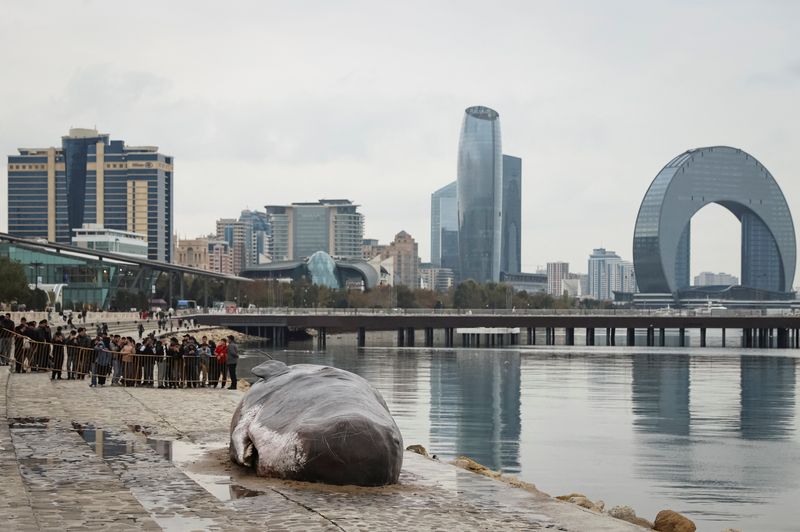By Gloria Dickie
BAKU (Reuters) – This 12 months’s U.N. local weather summit – COP29 – is being held throughout one more record-breaking 12 months of upper international temperatures, including strain to negotiations geared toward curbing local weather change.
The final international scientific consensus on local weather change was launched in 2021 via the Intergovernmental Panel on Local weather Change, nonetheless scientists say that proof reveals international warming and its impacts are unfolding sooner than anticipated.
Right here is a few of the newest local weather analysis:
1.5C BREACHED?
The world might have already got hit 1.5 diploma Celsius (2.7 F) of warming above the common pre-industrial temperature – a crucial threshold past which it’s prone to irreversible and excessive local weather change, scientists say.
A gaggle of researchers made the suggestion in a research launched on Monday primarily based on an evaluation of two,000 years of atmospheric gases trapped in Antarctic ice cores that extends the understanding of pre-industrial temperature developments.
Scientists have usually measured as we speak’s temperatures in opposition to a baseline temperature common for 1850-1900. By that measure, the world is now at almost 1.3 C (2.4 F) of warming.
However the brand new information suggests an extended pre-industrial baseline, primarily based on temperature information spanning the 12 months 13 to 1700, the research printed within the journal Nature Geoscience stated.
Both manner, 2024 is for certain to be the warmest 12 months on report.
SUPERCHARGED HURRICANES
Not solely is ocean warming fuelling stronger Atlantic storms, it’s also inflicting them to accentuate extra quickly, for instance, leaping from a Class 1 to a Class 3 storm in simply hours.
Rising proof reveals that is true of different ocean basins.
Hurricane Milton wanted solely sooner or later within the Gulf of Mexico in October to go from tropical storm to the Gulf’s second-most highly effective hurricane on report, slamming Florida’s west coast.
Hotter air also can maintain extra moisture, serving to storms carry and ultimately launch extra rain. Consequently, hurricanes are delivering flooding even in mountain cities like Asheville, North Carolina, inundated in September by Hurricane Helene.
WILDFIRE DEATHS
World warming is drying waterways and sapping moisture from forests, creating circumstances for greater and warmer wildfires from the U.S. West and Canada to southern Europe and Russia’s Far East creating extra damaging smoke.
Analysis printed final month in Nature Local weather Change calculated that about 13% of deaths related to poisonous wildfire smoke, roughly 12,000 deaths, throughout the 2010s may very well be attributed to the local weather impact on wildfires.
CORAL BLEACHING
With the world within the throes of a fourth mass coral bleaching occasion — the biggest on report — scientists concern the world’s reefs have handed a degree of no return.
Scientists will likely be learning bleached reefs from Australia to Brazil for indicators of restoration over the following few years if temperatures fall.
AMAZON ALARM
Brazil’s Amazon (NASDAQ:) is within the grips of its worst and most widespread drought since data started in 1950. River ranges sank to all-time lows this 12 months, whereas fires ravaged the rainforest.
This provides concern to scientific findings earlier this 12 months that between 10% and 47% of the Amazon will face mixed stresses of warmth and drought from local weather change, in addition to different threats, by 2050.
This might push the Amazon previous a tipping level, with the jungle now not in a position to produce sufficient moisture to quench its personal bushes, at which level the ecosystem might transition to degraded forests or sandy savannas.
Globally, forests look like struggling.
A July research discovered that forests total final 12 months failed to soak up as a lot carbon dioxide from the environment as previously, due largely to the Amazon drought and wildfires in Canada.
Which means a report quantity of CO2 entered the environment.
VOLCANIC SURGE
Scientists concern local weather change might even enhance volcanic eruptions.
In Iceland, volcanoes look like responding to fast glacier retreat. As ice melts, much less strain is exerted on the Earth’s crust and mantle.
Volcanologists fear this might destabilize magma reservoirs and seems to be resulting in extra magma being created, increase strain underground.
Some 245 volcanoes the world over lie below or close to ice and may very well be in danger.
OCEAN SLOWDOWN
The warming of the Atlantic might hasten the collapse of a key present system, which scientists warn might already be sputtering.

The Atlantic Meridional Overturning Circulation (AMOC), which transports heat water from the tropics to the North Atlantic, has helped to maintain European winters milder for hundreds of years.
Analysis in 2018 confirmed that AMOC has weakened by about 15% since 1950, whereas analysis printed in February within the journal Science Advances, advised that it may very well be nearer to a crucial slowdown than beforehand thought.



